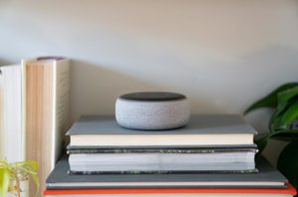But outfitting your home with smart devices is expensive, right? Actually, not really. You can set up the building blocks of a smart home for just a couple hundred bucks (or less, in some cases). This guide will walk you through the steps to build a smart home on a shoestring budget. Let’s start with the basics. While each household will be different, we recommend at least 100–200 Mbps for most connected households and up to 1 GB internet speeds for big houses with lots of devices. If you’re not sure how fast your existing internet is, you can test it out using our speed test. While some smart home devices can use bluetooth, smart hubs, or even wired connections, your Wi-Fi network will be the main way that most of your devices communicate with each other, your personal apps, and the wider world. This means it is also essential to have a powerful modem and router. Tons of devices have Alexa built in and even more are compatible with the system, meaning they can be controlled by giving a voice command to your speaker. Adding new devices to your ecosystem is made easy with the Alexa app. One advantage to Google Assistant is that it’s already built-in to many Android phones as the default assistant. That means many people may already be using it as they go about their day-to-day activities. Another benefit to using Google’s Assistant is, well, Google. There’s no other digital voice assistant that can answer questions as accurately and helpfully as Google. While we appreciate the design (of course) and overall functionality of Apple’s HomeKit, there are fewer devices that have the system built-in than for the other two ecosystems. That said, the list of compatible devices is growing, and those who are already embedded in the Apple universe should find plenty to love with HomeKit. Smart hubs can get really fancy. Some of the best smart hubs can help you connect devices that are on different ecosystems, even if they aren’t technically able to “pair” with each other directly. Hubs can make it easier to connect devices that are in different parts of your home, even those that are far away from each other. Here we’re just going to cover some of the more essential and popular smart home devices that you’ll want to invest in, even if you’re trying to be budget conscious. Let’s start with the most basic: smart plugs. Spend less than $100 to throw some high-quality smart plugs in each room of your house and you’re basically halfway to having a smart home. If you really want to invest in good sound, check out wireless surround sound systems from companies like Bose, Yamaha, Sonos, and VIZIO. These systems can essentially make your whole home a voice-activated, entertainment center. The best thermostats out there (like the Ecobee SmartThermostat) can control your heating, cooling, air filtration, and hot water systems, among others. You can install occupancy sensors, so the system knows when you’re home and which rooms you’re using, and adjust the climate to suit your needs. While these systems can cost a few hundred bucks, you will probably notice a lower energy bill in the coming months, so it kind of pays for itself. You can get smart lights that do all sorts of things, from the basics—remote control and fading—to complex tasks—like changing color and pulsing to the music that’s coming from your smart speaker. You probably don’t need a smart light in every room, but the bigger spaces where you spend a lot of time and entertain are essential. Top tier home security systems will come with smart cameras, professional monitoring, window sensors, and other features that make it easy to feel safe at home (and away). There are a range of options out there, from contract-free, DIY installation kits to more professional services. The best systems, like those from Vivint, will be able to seamlessly plug into your larger smart home ecosystem. These little devices let you see who’s knocking (or not knocking) at your door. But they can also help you monitor packages that arrive, see strange activity on your lawn or street, and store recorded video for later use. Outdoor security cameras can serve a similar function for other parts of your property. But you can also turn an older device into a (semi-)smart TV by attaching a streaming device that can hook up to the internet. Same goes for carbon monoxide detectors. Smart devices make it easier to track patterns (does it always go off at the same time of day?), get alerts when you’re away, and change the batteries at correct intervals. Unless you’re a serious gadget head, it can make sense to wait for a year or two after a new product is released. The cost goes down, the bugs get fixed, and you don’t end up investing in a passing fad (I feel bad for all those people who paid $1,500 for a pair of Google glasses that never really took off). How to set up a smart home on the cheap:
